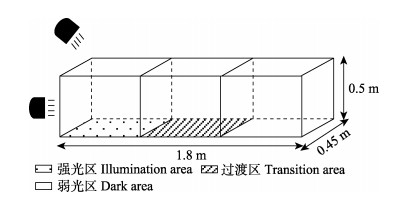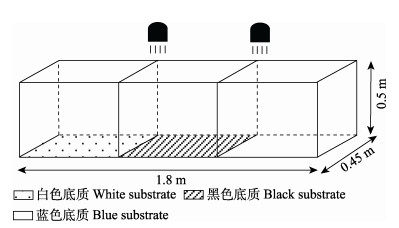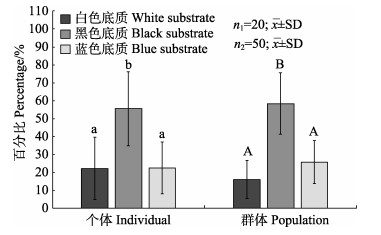2. 西北农林科技大学动物科技学院 陕西 杨凌 712100;
3. 中国水产科学研究院黄河水产研究所 陕西 西安 710000;
4. 贵州大学特种水产研究所 贵州 贵阳 550025;
5. 太白县水产工作站 陕西 宝鸡 722300
2. College of Animal Science and Technology, Northwest A&F University, Yangling 712100, China;
3. Yellow River Fisheries Research Institute, Chinese Academy of Fishery Sciences, Xi'an 710000, China;
4. Special Fishes Research Institute, Guizhou University, Guiyang 550025, China;
5. Fishery Workstation of Taibai County, Baoji 722300, China
鱼类的行为和生存状况受栖息水域中诸多环境因子影响,如温度、光环境、水流、底质等(蔡厚才等, 1998)。光环境作为重要的环境因子之一,主要包括光照强度、光照颜色和光周期,有研究表明,强光(> 340 lx)显著促进了大西洋鲑(Salmo salar)的生长(Oppedal et al, 1997),随后证实连续光照也能促进大西洋鲑的生长,并随着光照强度的升高,生长率提高(Stefansson et al, 1993)。顾孝连等(2009)研究发现,长江口中华鲟(Acipenser sinensis)幼鱼摄食率受光照强度影响不明显,但对光照强度具有正趋向性,其正趋光性有利于寻找食物丰富的栖息环境;而川陕哲罗鲑(Hucho bleekeri)在弱光(1.11 lx)下受精卵孵化率显著高于强光(570 lx),且孵出时间早于强光(王成友等, 2019)。与光照强度相似,光照颜色也可影响鱼类的摄食、生长、繁殖等生理活动,如虹鳟(Oncorhynchus mykiss)在红光下皮质醇、超氧化物歧化酶(SOD)、和过氧化氢酶(CAT)含量最高,受到的胁迫最强,生长缓慢;在绿光下皮质醇含量最低,受到的胁迫最弱,生长最快(赵鑫等, 2021)。鲫(Carassius auratus)在蓝光下红细胞、血红蛋白、球蛋白含量最高,免疫生理反应最好,生长率最快(Salwa et al, 2021)。在红光下,银化期大西洋鲑的日增重、摄食率以及存活率最高(张海耿等, 2020)。在黄光下,红鳍东方鲀(Takifugu rubripes)受精卵孵化时间比白光早2 d (魏平平等, 2020)。此外,鱼类栖息地也体现在底质颜色的选择上,比如长江口日本鳗鲡(Anguilla japonica)为躲避敌害而选择黑色底质便于藏匿,有利于提高其生存能力(龚盼等, 2015);史氏鲟(Acipenser schrenckii)为便于发现和捕食细小的饵料而选择白色底质(李大鹏等, 2001);黑斑原
秦岭细鳞鲑(Brachymystax tsinlingensis)隶属于鲑形目(Salmoniformes)、鲑科(Salmonidae)、细鳞鲑属(Brachymystax),别名花鱼(陕西)和梅花鱼(甘肃)等,为我国特有冷水性鱼类,仅分布在秦岭太白山峰的黑河、石头河、赤水河和太白河等河段及陇县千河支流、甘肃渭河支流(李思忠, 1966)。由于秦岭细鳞鲑应激性强、生境条件苛刻、生长缓慢(邵俭等, 2018),加之受人为过度捕捞等影响,秦岭细鳞鲑野生种群数量急剧锐减,个体小型化趋势明显,种质资源破坏严重,已被列入国家二级保护动物(乐佩琦等, 1998)。近年来,有学者先后对秦岭细鳞鲑的早期发育(施德亮等, 2012)、年龄与生长(薛超等, 2013)、遗传与繁殖(Shao et al, 2017)等方面做了大量研究。秦岭细鳞鲑人工繁殖技术已取得初步突破(邵俭等, 2014),但苗种培育成活率相对较低。我们在前期育苗研究中发现,光环境和底质条件是影响苗种成活的关键因子,但迄今为止相关研究仍十分匮乏。因此,本研究旨在对秦岭细鳞鲑子代进行光环境、底质颜色等行为学实验,探讨秦岭细鳞鲑稚鱼对光照环境因子以及底质颜色的行为选择,以期了解秦岭细鳞鲑栖息环境偏好,为其苗种培育和资源恢复提供参考。
1 材料与方法 1.1 实验鱼实验鱼为2021年4月在陕西省太白县白云峡秦岭细鳞鲑人工繁育试验基地通过对人工驯养的亲鱼催产、孵化所得。随机挑选同批次生产、体质健壮的鱼苗进行实验,其全长为2.23~4.57 cm,平均全长为(3.31±0.67) cm;体重为0.21~0.77 g,平均体重为(0.42±0.18) g。实验前先将实验鱼转至实验水槽中适应10 d,避免应激产生,消除实验误差。
实验鱼每日投喂6次(投喂时间为08:00、10:00、12:00、16:00、18:00和20:00),投喂饵料为丰年虫(Artemia salina)+水蚯蚓(Limnodrilus hoffmeisteri);实验用水为经充分沉淀过滤后的山涧溪流,水质参数使用YSI ProPlus多参数水质仪测定,见表 1。实时监测实验鱼在适应期的摄食情况,发现第5天实验鱼摄食行为明显,摄食效果达到最佳,可认定为已完全适应实验环境。实验开始前2 h对实验鱼不进行投喂,避免摄食因素影响实验结果。
|
|
表 1 水质参数 Tab.1 Water quality parameters |
将水族箱(长1.80 m×宽0.45 m×高0.50 m)分成面积相等的3个区域,再以2只15 W白炽灯提供唯一光源放在水族箱一端,调节2个白炽灯与水族箱的距离,使水族箱3个等面积区域照度为弱光区为1~5 lx,过渡区为5~10 lx,强光区为10~25 lx (图 1)。光照强度由Spectrum LightScout光量子计(3415F)多次重复测定。每组实验后调换强区弱区位置,消除位置适应性误差。

|
图 1 光照强度实验示意图 Fig.1 Sketch map for light intensity preference test |
将水族箱进行清洗消毒后加入实验用水,水深为20.06~21.50 cm,水质情况见表 1。
个体实验:从暂养槽随机挑选20尾实验鱼进行实验,每次从水族箱中央(过渡区中央)放入1尾鱼,适应2 min后,利用摄像机连续录像5 min,再新取出下一尾鱼按同样的方法进行实验;统计每尾鱼在3种不同照度区域中停留的时间,以实验鱼在不同照度区域中的时间百分比平均数作为个体对不同光照强度的选择性指标。
群体实验:从暂养槽随机挑选30尾实验鱼并分为5组进行实验,每组6尾鱼同时放入水族箱中央,适应2 min后,每间隔30 s记录1次,记录在不同光照区域的实验鱼数量,每组记录10次,再新取出下一组实验鱼按同样的方法进行实验;计算不同光照强度区域中实验鱼的数量百分比,以各个区域中的数量百分比平均数作为群体对不同光照强度选择性的指标。
所有实验统计时,以实验鱼头部进入某个区域作为处于该区域的标准,开始计时或计数。
1.2.2 底质颜色选择实验用白色、黑色、蓝色大小相等、不透光彩布(长0.60 m×宽0.45 m)将水族箱底部铺设成面积相等的3个区域,再将2只15 W白炽灯作为唯一光源置于水族箱的正上方,调节两灯间的位置,使3个等面积区域的光照强度均为20~25 lx (图 2)。每组实验结束后交换底质位置,消除位置适应性误差。

|
图 2 底质颜色实验示意图 Fig.2 Sketch map for substrate color preference test |
底质颜色选择实验与趋光性实验类似。
个体实验:随机选20尾实验鱼,每次放入1尾进行实验;统计每尾鱼在各个区域停留的时间,以实验鱼在各个区域的时间百分比平均数作为个体对不同底质颜色的选择性指标。
群体实验:每组随机挑选30尾实验鱼,每次放入6尾进行实验;计算每次记录时各个区域实验鱼的数量百分比,以各个区域中的数量百分比平均数作为群体对不同底质颜色的选择性指标。
1.2.3 光照颜色选择实验在水族箱内用3块面积相等的不透光挡板(长0.45 m×宽0.20 m)将水族箱划分为4个等面积区域,再以1 W的黄色、红色、绿色和蓝色4种颜色的LED彩灯作为每个等面积区域内的唯一光源,置于水族箱正上方中心的同一平线上,使4个等面积区域的光照强度都为1~3 lx (图 3)。每组实验结束后采用顺时针方向交换光色位置,消除位置适应性和光色组合带来的误差。

|
图 3 光照颜色选择实验示意图 Fig.3 Sketch map for light color preference test |
个体实验:每次放入1尾实验鱼,共重复20次;统计每尾鱼在各个区域停留的时间,以实验鱼在各个区域的时间百分比平均数作为个体对不同光色的选择性指标。
群体实验:每次同时放入6尾实验鱼,共重复5次;计算每次记录时各个区域中实验鱼的数量百分比,以各个区域中的数量百分比平均数作为群体对不光色的选择性指标。该实验部分参照周显青等(2000)对鱼类光色偏好研究,光照颜色设计为黄色、红色、绿色和蓝色4种。
1.3 数据处理运用非参数统计方法Kruskal-Wallis Test检验各区域内活动时间百分比和分布数量百分比差异显著性,利用单因素方差分析(one-way ANOVA)中Duncan法进行多重比较检验两两区域间显著性分析(王恒等, 2014)。数据使用Excel 2016和SPSS 25软件进行统计分析,结果均采用平均值±标准差(Mean±SD)表示。
2 结果 2.1 趋光性行为秦岭细鳞鲑稚鱼在3个照度区域(强光区、过渡区和弱光区)内的个体停留时间百分比为(35.49± 27.88)%、(27.14±16.71)%和(37.37±31.43)%,实验发现,20尾稚鱼中的3尾行为个性显著,再次统计分析其余17尾的个体停留时间百分比则为(35.60± 20.23)%、(32.51±11.81)%和(31.89±21.38)%;以上各照度区差异均不显著(P > 0.05)。群体分布尾数数量百分比为(21.33±10.24)%、(36.00±5.08)%和(42.67±10.24)%,群体在强光区的分布尾数数量百分比低于弱光区和过渡区,且差异显著(P < 0.05),弱光区和过渡区间无显著性差异(P > 0.05),表明群体对强光有负趋向性(图 4)。

|
图 4 秦岭细鳞鲑稚鱼趋光性 Fig.4 Preference for illumination intensity of juvenile B. tsinlingensis n1表示个体实验的样本量;n2表示群体实验的样本量。不同字母表示差异显著(P < 0.05)。下同。 n1 denotes the sample size of individual experiments; n2 denotes the sample size of population experiments. Different letters indicate significant differences (P < 0.05). The same as below. |
实验照度范围为20~25 lx,秦岭细鳞鲑稚鱼在3种颜色底质(白色、黑色和蓝色)内,个体停留时间百分比依次为(22.13%±17.46)%、(55.48±20.62)%和(22.39±14.45)%,在黑色底质区域活动时间百分比显著高于其他区域(P < 0.05);群体分布尾数数量百分比依次为(16.00±10.58)%、(58.33±17.16)%和(25.67± 12.05)%,群体在黑色底质的数量百分数高于白色底质和蓝色底质,且差异显著(P < 0.05),白色底质和蓝色底质间无显著差异(P > 0.05)(图 5)。结果表明,秦岭细鳞鲑稚鱼偏好于黑色底质,对白色底质和蓝色底质均偏好不明显。

|
图 5 秦岭细鳞鲑稚鱼对底质颜色的选择 Fig.5 Preference for substrate color of juvenile B. tsinlingensis 小写字母代表不同处理组个体之间的差异性;大写字母代表不同处理组群体之间的差异性。 Lowercase letters represent the variability between individuals in different treatment groups, and uppercase letters represent the variability between groups in different treatment groups. |
实验照度范围为20~25 lx,秦岭细鳞鲑稚鱼在黄、红、绿和蓝色4种光照颜色区域内,个体停留时间百分比依次为(26.15±23.72)%、(28.38± 20.12)%、(24.29± 17.81)%和(21.19±16.77)% (图 6),在蓝色区域的分布率(34.33±14.07)%最高,黄色(33.00±14.20)%次之,绿色区域的分布率最低,仅(12.67±3.65)%,蓝光和黄光显著高于绿光(P < 0.05),对4种光照颜色的喜好排序:蓝色 > 黄色 > 红色 > 绿色。稚鱼在绿光分布尾数数量百分比低于其他光区,且差异显著(P < 0.05) (表 2),蓝光和黄光区间无显著性差异(P > 0.05),群体对绿光有负趋向性。

|
图 6 秦岭细鳞鲑稚鱼对光照颜色的选择 Fig.6 Preference for light color of juvenile B. tsinlingensis |
|
|
表 2 秦岭细鳞鲑稚鱼在4种颜色区域的分布率及差异显著性 Tab.2 Distribution rate and significant difference of juvenile B. tsinlingensis in four kinds of color regions |
鱼类对光刺激产生定性运动的特征称为趋光性,不同鱼类对光强的敏感性不同,朝向光源运动称为正趋光性,背离光源运动称为负趋光性(俞文钊, 1981)。鱼类对光照强度的选择是其对栖息选择的适应表现,许多中上层鱼具有正趋光性,如罗非鱼(Oreochromis niloticus) (杨弘等, 2011)、大西洋鲟(Acipenser sturios) (Kynard et al, 2002)、鲫(巩建华等, 2016)等。而底栖性鱼类由于栖息、索饵、繁殖于河底,光线对其作用较弱,对光照刺激呈现负趋光性(茅绍廉, 1985),如瓦氏黄颡鱼(Pelteobagrus vachelli) (路波等, 2012)、大西洋鲑(Pinhorn et al, 1965)。本研究发现,秦岭细鳞鲑稚鱼对光照强度呈负趋向性,与秦岭细鳞鲑自然种群喜好遮蔽度高的山涧溪流深潭等昏暗环境相吻合。鱼类的趋光性是鱼类探寻适宜照度的结果,并经常在该照度的水域内集群(蔡厚才等, 1988),四川裂腹鱼(Schizothorax kolzovi)常在10.0~39.5 lx照度范围内集群明显(董登攀等, 2021),与秦岭细鳞鲑稚鱼在1~10 lx照度区域集群明显不一致。行为是生物长期进化的结果,鱼类所选择的生活条件及行为也是其长期进化的结果(Clarke et al, 1981),集群行为可以更快获取信息、有效躲避敌害、增强适应能力(周应祺等, 2013)。秦岭细鳞鲑稚鱼对光照强度的负趋向性以及弱照度下的集群行为都是其对栖息地选择的自然进化表现。鱼类视觉器官中视网膜形态组合与其生存的环境相适应,其中,视柱细胞对光照强度较为敏感,可以分辨明暗(蔡厚才等, 1988),秦岭细鳞鲑趋向弱光与视网膜形态结构的关系还有待后续研究。
3.2 秦岭细鳞鲑稚鱼的底质颜色选择秦岭细鳞鲑稚鱼游经黑色底质的水族箱区域时游动缓慢、停留时间长,说明其对黑色底质有明显偏好,与依靠嗅觉夜间摄食的革胡子鲶(Clarias gariepius) (汪留全等, 1990)、黑斑原
秦岭细鳞鲑稚鱼在黄色、红色、绿色和蓝色4种光色区域具有选择性停留,并且会尝试其他区域,当其游经绿色区域时表现为游动突然加速通过该区域或者选择回避该区域,表现出惊慌不安远离逃窜,趋避行为明显;在黄色区域表现出游泳缓慢、有序游动,自主巡游,活动稳定;以上说明秦岭细鳞鲑对黄光具有正趋向性,而对绿光具有负趋向性,充分证明秦岭细鳞鲑具有一定的辨色能力。根据光谱理论可知,由于水的吸收和反射作用,太阳光穿过水层时,大部分红光会被滤掉(Volpato et al, 2001; 张延青等, 2020),水体底层主要以蓝绿光为主。秦岭细鳞鲑常栖息于黑色底层,其视觉特征与自然栖息环境相适应。罗会明(1985)研究表明,鱼类在游动过程中会对看到的灯光感到好奇,因而产生探索性反射,趋向光源。当红光突然出现时可能会与秦岭细鳞鲑喜好的栖息环境出现较大反差,产生探索性反射而趋向光源。因此,秦岭细鳞鲑对红光具有探索性趋向,而对绿光具有趋避性,在培育过程中避免使用红色和绿色光源, 可以降低秦岭细鳞鲑对环境的探索和趋避行为,从而有效减少应激反应、提高成活率。
3.4 秦岭细鳞鲑稚鱼个体、群体间选择行为差异鱼类个体行为在不同情境下表现出稳定的差异称为“个性”,群体间的个体行为差异有利于集体协同作用(张东等, 2021)。本研究表明,秦岭细鳞鲑个体、群体间的底质颜色选择结果保持一致,而光照强度和光照颜色选择实验中个体、群体间的结果有趋向性分歧;秦岭细鳞鲑稚鱼个体对光照强度和光照颜色趋向性不明显,而群体对强光和绿光负趋向性明显。张嫱等(2017)认为,具有“冒险型个性”的个体能对环境进行快速探索,因此,在群体中通常占据主导地位。秦岭细鳞鲑与褐鳟(Salmo trutta)、虹鳟等群体中也有“冒险型”的个体(Fredrik et al, 2004; Sneddon, 2003)。同时,鱼类在集群中可以通过个体间相互传递信息(周应祺等, 2013),秦岭细鳞鲑群体中“冒险型”个体将环境信息传递给其他鱼,使其更快地趋避不利环境,即减少探索时间,有更多时间停留在适宜照度和光色区域,导致群体趋避性明显(任为公, 1992)。个体和群体不同的现象原因有多种,Chan等(1997)对海湾鲟(gulf sturgeons)研究发现,群体间由于存在种内斗争会对卵石回避或无选择,而个体选择卵石;大型鱼类中华鲟群体由于部分进入亮光区的幼鱼进行适应性圆周运动,迫使其他幼鱼更多停留在过渡区,而个体更多停留在亮光区(王恒等, 2014)。本研究中,秦岭细鳞鲑稚鱼群体能更快趋避强光区和绿光区,停留时间较短,而个体停留时间较长,这可能是集群后群体与个体信息传递特征或环境反应机制不同所导致。
4 结论秦岭细鳞鲑属冷水性鱼类,生长缓慢,应激性强,基于研究结果并结合秦岭细鳞鲑早期生物学特性,建议在秦岭细鳞鲑苗种培育与资源增殖过程中,尤其是在稚鱼期,其光照强度设置为1~10 lx,使用黑色或深色底质的养殖设施,避免使用绿色和红色光色的光源,以上措施将会利于秦岭细鳞鲑稚鱼集群行为产生,降低应激行为频次和减少能量消耗,从而使其生长发育、摄食和存活率等方面得到改善。需要强调的是,本研究仅针对秦岭细鳞鲑早期发育关键阶段,关于其他发育阶段及其行为规律有待于后续进一步研究。
CAI H C, HE D R. Fish behavioristics. Xiamen: Xiamen University Press, 1998: 1-12 [蔡厚才, 何大仁. 鱼类行为学. 厦门: 厦门大学出版社, 1998: 1-12]
|
CHAN M D, DIBBLE E D, KILGORE K J. A laboratory examination of water velocity and substrate preference by age-0 gulf sturgeons. Transactions of the American Fisheries Society, 1997, 126(2): 104-115 |
CLARKE W C, SHELHOURN T E, BRETT T R. Effect of artificial photoperiod cycles, temperature and salinity on growth and smolting in underyearling coho (Oncorhynchus kisutch), chinook (O. tshawytscha) and sockeye (O. nerka) salmon. Aquaculture, 1981, 22(4): 105-116 |
DONG D P, LI F B, WAN D, et al. Studies on influence of illumination on schooling behavior of Schizothorax kozlovi. Transactions of Oceanology and Limnology, 2021, 43(2): 39-143 [董登攀, 李富兵, 万东, 等. 光照对四川裂腹鱼集群行为的影响研究. 海洋湖沼通报, 2021, 43(2): 39-143] |
FREDRIK S L, ERIK P, JOHAN H, et al. Hatchery selection promotes boldness in newly hatched brown trout (Salmo trutta): Implications for dominance. Behavioral Ecology, 2004, 15(2): 192-198 DOI:10.1093/beheco/arg089 |
GONG J H, GUO C Y, TIAN Z, et al. Study on the selectivity of Carassius auratus under different environment colors and luminous intensities. Journal of Biology, 2016, 33(5): 13-18 [巩建华, 郭春阳, 田喆, 等. 红鲫鱼对环境颜色及光强的趋向性研究. 生物学杂志, 2016, 33(5): 13-18] |
GONG P, HOU J L, ZHUANG P, et al. Selective behavior of Anguilla japonica glass eel on substrate color and light intensity in the Yangtze estuary. Marine Fisheries, 2015, 37(6): 510-516 [龚盼, 侯俊利, 庄平, 等. 长江口日本鳗鲡鳗苗对底质颜色和光照强度的选择行为. 海洋渔业, 2015, 37(6): 510-516] |
GU X L, ZHUANG P, ZHANG L Z, et al. Illumination intensity preference and its effects on feeding efficiency of juvenile Chinese sturgeon, Acipenser sinensis captured from the estuary of Yangtze River. Journal of Fisheries of China, 2009, 33(5): 778-783 [顾孝连, 庄平, 章龙珍, 等. 长江口中华鲟幼鱼趋光行为及其对摄食的影响. 水产学报, 2009, 33(5): 778-783] |
KYNARD B, HORGAN M. Ontogenetic behavior and migration of Atlantic sturgeon, Acipenser oxyrinchus oxyrinchus, and shortnose sturgeon, A. brevirostrum, with notes on social behavior. Environmental Biology of Fishes, 2002, 63(2): 137-150 DOI:10.1023/A:1014270129729 |
LI D P, ZHUANG P, WANG M X, et al. Preference of illumination and influence of different photoperiods on growth of juvenile Amur sturgeon (Acipenser schrenckii). Journal of Huazhong Agricultural University, 2001, 20(6): 564-567 [李大鹏, 庄平, 王明学, 等. 史氏鲟稚鱼的趋光性及不同光照周期对其生长的影响. 华中农业大学学报, 2001, 20(6): 564-567] |
LI S Z. On a new subspecies of fresh-water tout, Brachymytax lenok tsinlingensis, from Taipaishan, Shansi, China. Zoological Systematics, 1966, 3(1): 92-94 [李思忠. 陕西太白山细鳞鲑的一新亚种. 动物分类学报, 1966, 3(1): 92-94] |
LU B, SHI X T, LIU D F, et al. White and black substrate preference and hiding behavior of Pelteobagrus vachelli. Journal of Hydroecology, 2012, 33(5): 36-40 [路波, 石小涛, 刘德富, 等. 瓦氏黄颡鱼对黑白底质颜色偏好和藏匿行为研究. 水生态学杂志, 2012, 33(5): 36-40] |
LUO H M. The principle of phototropism of marine economic animals. Fuzhou: Fujian Science and Technology Publishing Press, 1985: 60-62 [罗会明. 海洋经济动物趋光原理. 福州: 福建科学技术出版社, 1985: 60-62]
|
MAO S L. Fish action and fishing techniques. Beijing: China Ocean Press, 1985: 119-157 [茅绍廉. 鱼类行动与捕鱼技术. 北京: 海洋出版社, 1985: 119-157]
|
OPPEDAL F, TARANGER G L, JUELL E J, et al. Light intensity affects growth and sexual maturation of Atlantic salmon (Salmo salar) postsmolts in sea cages. Aquatic Living Resources, 1997, 10(6): 351-357 DOI:10.1051/alr:1997038 |
PINHORN A, ANDREWS C. Effect of photoperiods on the behavior of juvenile Atlantic salmon (Salmo salar L. ) in vertical and horizontal light gradients. Journal of the Fisheries Board of Canada, 1965, 22(2): 369-383 |
REN W G. Aims and methods of studying fish behavior. Marine Fisheries, 1992, 14(5): 221-224 [任为公. 研究鱼类行为的目的与方法. 海洋渔业, 1992, 14(5): 221-224] |
SALWA M N, AMANY M D, RADI A M, et al. Effect of different monochromatic LED light colors on growth performance, behavior, immune-physiological responses of gold fish, Carassius auratus. Aquaculture, 2021, 538(30): 73652-73661 |
SHAO J, CHU Z P, LU B, et al. Effects of different baits on the growth and survival of seedling Brachymytax tsinlingensis. Scientific Fish Farming, 2018(8): 26-28 [邵俭, 褚志鹏, 陆斌, 等. 不同饵料对秦岭细鳞鲑苗种生长及存活的影响. 科学养鱼, 2018(8): 26-28] |
SHAO J, LUO W, WEI Q W, et al. Assignment of parentage by microsatellite analysis in the endangered Brachymystax lenok tsinlingensis (Salmonidae). Aquatic Biology, 2017, 26: 69-73 |
SHAO J, WEI Q W, WU J M, et al. An artificial breeding method for Brachymystax lenok tsinlingensis: 201410319444.1. 2014–09–17 [邵俭, 危起伟, 吴金明, 等. 一种秦岭细鳞鲑人工繁育方法: 201410319444.1. 2014–09–17]
|
SHI D L, WEI Q W, SUN Q L, et al. Early ontogenesis of Brachymystax lenok tsinlingensis. Journal of Fishery Sciences of China, 2012, 19(4): 557-567 [施德亮, 危起伟, 孙庆亮, 等. 秦岭细鳞鲑早期发育观察. 中国水产科学, 2012, 19(4): 557-567] |
SHI D L. Study on early ontogenesis of Brachymystax lenok tsinlingensis. Master′s Thesis of Huazhong Agricultural University, 2012, 4–14 [施德亮. 秦岭细鳞鲑早期发育研究. 华中农业大学硕士研究生学位论文, 2012, 4–14]
|
SNEDDON L U. The bold and the shy: Individual differences in rainbow trout. Journal of Fish Biology, 2003, 62(4): 971-975 |
STEFANSSON S O, HANSEN T J, TARANGER G L. Growth and parr-smolt transformation of Atlantic salmon (Salmo salar L. ) under different light intensities and subsequent survival and growth in seawater. Aquacultural Engineering, 1993, 12(4): 231-243 |
VOLPATO G L, BARRETO R. Environmental blue light prevents stress in the fish Nile tilapia. Brazilian Journal of Medical and Biological Research, 2001, 34: 1041-1045 |
WANG C Y, DU H, WU J M, et al. Effect of illumination on the hatching of Sichuan taimen (Hucho bleekeri kimura) eggs. Freshwater Fisheries, 2019, 49(1): 62-65 [王成友, 杜浩, 吴金明, 等. 光照对川陕哲罗鲑受精卵孵化的影响. 淡水渔业, 2019, 49(1): 62-65] |
WANG H, WEI Q W, LI W, et al. Light intensity preferences of 5-month and 7-month F2 Chinese sturgeon (Acipenser sinensis). Journal of Fisheries of China, 2014, 38(7): 929-938 [王恒, 危起伟, 李伟, 等. 5月龄、7月龄中华鲟子二代光照偏好性研究. 水产学报, 2014, 38(7): 929-938] |
WANG L Q, CHENG Y S. On the feeding habits and growth for larval of Clarias lazera under pond nursery. Journal of Fisheries of China, 1990, 14(2): 105-113 [汪留全, 程云生. 池养条件下革胡子鲶仔幼鱼摄食习性与生长的初步研究. 水产学报, 1990, 14(2): 105-113] |
WEI P P, LI X, ZHANG J P, et al. Effects of LED spectra on morphological characters and gene expression of growth in Takifugu rubripes larvae. Progress in Fishery Sciences, 2020, 41(1): 162-168 [魏平平, 李鑫, 张俊鹏, 等. LED光谱对红鳍东方鲀仔稚鱼形态性状及生长相关基因表达的影响. 渔业科学进展, 2020, 41(1): 162-168] |
WU J M, YANG H C, SHAO J, et al. Habitat environmental characteristics of Brachymystax lenok tsinlingensis. Acta Hydrobiologica Sinica, 2017, 41(1): 214-219 [吴金明, 杨焕超, 邵俭, 等. 秦岭细鳞鲑栖息地环境特征研究. 水生生物学报, 2017, 41(1): 214-219] |
XI J, ZHENG Z L, MOU Z B, et al. Study on the hiding behavior of the Glyptosternum maculatum larvae and juveniles. Acta Hydrobiologica Sinica, 2021, 45(5): 1129-1137 [席杰, 郑宗林, 牟振波, 等. 黑斑原鮡仔稚鱼藏匿行为研究. 水生生物学报, 2021, 45(5): 1129-1137] |
XUE C, WEI Q W, SUN Q L, et al. Age and growth of Brachymystax lenok tsinlingensis. Journal of Fishery Sciences of China, 2013, 20(4): 743-749 [薛超, 危起伟, 孙庆亮, 等. 秦岭细鳞鲑的年龄与生长. 中国水产科学, 2013, 20(4): 743-749] |
YANG H, JIANG Y, XIAO W, et al. Studies on the photo taxis of Nile tilapia (Oreochromis niloticus) during different growth stages. Chinese Agricultural Science Bulletin, 2011, 27(32): 61-65 [杨弘, 江苑, 肖炜, 等. 尼罗罗非鱼不同生长阶段的趋光性研究. 中国农学通报, 2011, 27(32): 61-65] |
YU W Z. Investigations on the phototropism behaviour of fishes. Journal of Psychologica Science, 1981, 4(2): 11-16 [俞文钊. 鱼类的趋光行为研究. 心理科学通讯, 1981, 4(2): 11-16] |
YUE P Q, CHEN Y Y. China red data book of endangered animals: Pisces. Beijing: Science Press, 1998: 35-37 [乐佩琦, 陈宜瑜. 中国濒危动物红皮书(鱼类). 北京: 科学出版社, 1998: 35-37]
|
ZHANG D, WANG L P. Fish personality: Implications for ecology, aquaculture and fisheries. Journal of Fishery Sciences of China, 2021, 28(10): 1346-1358 [张东, 王莉平. 知鱼、识鱼、管鱼: 从个性研究开始. 中国水产科学, 2021, 28(10): 1346-1358] |
ZHANG H G, ZHANG Y L, SONG H Q, et al. Effects of light color and photoperiod on growth and physiology of Salmo salar during smoltification. Fishery Modernization, 2020, 47(3): 16-21 [张海耿, 张宇雷, 宋红桥, 等. 光色和光照周期对大西洋鲑银化期生长及生理的影响. 渔业现代化, 2020, 47(3): 16-21] |
ZHANG Q, FU S J, XIA J G. Recent progress on the personality of fish. Chinese Journal of Ecology, 2017, 36(12): 3623-3628 [张嫱, 付世建, 夏继刚. 鱼类"个性"行为及其研究进展. 生态学杂志, 2017, 36(12): 3623-3628] |
ZHANG Y Q, QIN F, FEI F, et al. Analysis of propagation characteristics of LED light source in aquaculture water. Progress in Fishery Sciences, 2020, 41(1): 153-161 [张延青, 秦菲, 费凡, 等. LED光源在海水养殖水体中传播特征解析. 渔业科学进展, 2020, 41(1): 153-161] |
ZHAO X, LI L, DONG S L, et al. Effects of LED colors and melatonin treatment on antioxidant enzyme activities and relevant hormone concentrations of rainbow trout (Oncorhynchus mykiss). Journal of Fisheries of China, 2021, 45(1): 44-54 [赵鑫, 李丽, 董双林, 等. LED光色及注射褪黑素对虹鳟抗氧化酶活性及相关激素含量的影响. 水产学报, 2021, 45(1): 44-54] |
ZHOU X Q, NIU C J, LI Q F. Effects of light on feeding behavior, growth and survival of aquatic animals. Acta Hydrobiologica Sinica, 2000, 24(2): 178-181 [周显青, 牛翠娟, 李庆芬. 光照对水生动物摄食、生长和存活的影响. 水生生物学报, 2000, 24(2): 178-181] |
ZHOU Y Q, WANG J, QIAN W G, et al. Review of fish schooling behavior study. Journal of Shanghai Ocean University, 2013, 22(5): 734-743 [周应祺, 王军, 钱卫国, 等. 鱼类集群行为的研究进展. 上海海洋大学学报, 2013, 22(5): 734-743] |



